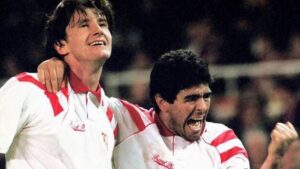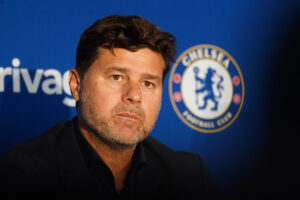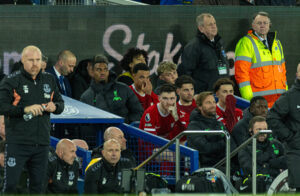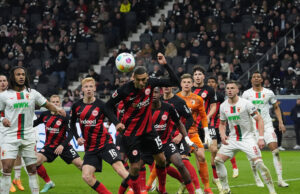Last night’s “invasion of the Emirates” by Cologne fans is already being described as the most successful Teutonic migration to England since the Angles and Saxons arrived in the fifth and sixth centuries AD. Although there were almost certainly some English-based German fans among the hordes who descended on north London, it appears that about 20,000 supporters travelled from Germany for the club’s first European fixture for a quarter of a century.
Considering only 3000 fans were meant to travel, this influx caused huge difficulties for Arsenal and its own fans. If the situation had been reversed and Arsenal fans without tickets had swamped Cologne, all English fans would have risked being banned from Europe. Nevertheless, it is a remarkable testament to the enduring popularity of one of Germany’s oldest and greatest clubs.
That popularity was largely built on the back of two great Cologne teams from the past. Their almost mythical feats have sustained the fans’ hunger in the ensuing decades, when the club has spent almost as much time in Bundesliga 2 as in Germany’s top division.
Indeed, the first of those two great sides were the winners of the first ever Bundesliga, in 1963-64. As Ulrich Hesse-Lichtenberger explains in his magisterial Tor!: The Story of German Football, the German game was relatively late in organising itself along national lines, especially in comparison with other major European footballing powers such as England, Italy and Spain. For most of the 20th century, German football was organised along regional, knock-out lines rather than having a truly national league. However, when the Bundesliga was finally formed in the early 1960s and kicked off in August 1963, it was Cologne, or 1. FC Köln to give them their full German name, who ultimately came out on top.
That inaugural Bundesliga-winning team was a fine all-round side, with forwards Karl-Heinz Thielen and Christian Müller scoring more than 30 league goals between them in what was only a 30-game competition.
Its greatest player, however, was undoubtedly Wolfgang Overath, Cologne’s greatest ever player and one of the greatest of all German players. Like Tony Adams or Paolo Maldini after him, he was a true one-club man, playing over 700 games and scoring nearly 300 goals for the club, which was proof of his genius as an attacking midfielder. In addition to winning the league with Cologne in 1964 and two German Cups in 1968 and 1977, he excelled at international level, winning more than 80 caps for the national side in a glittering career that culminated in their winning the 1974 World Cup on home soil against Holland.
After the Overath era ended in a victorious replay of the 1977 German Cup final, Cologne almost immediately found its next great side. The following season, 1977-78, they not only retained the German Cup but for good measure won the Bundesliga as well, to give the club its only league and cup double, and one of the few non-Bayern doubles in the history of the Bundesliga. Its twin stars were two more German internationals: in goal, the young Harald Schumacher, who would achieve such infamy at the 1982 World Cup for nearly maiming France’s Patrick Battiston, and striker Dieter Müller, who was the joint top scorer in the 1977-78 Bundesliga with 24 goals.
The other joint top scorer in Germany that season was yet another Müller, Bayern’s Gerd, who, even after the remarkable feats of Ronaldo and Messi in recent years, remains probably the greatest goal-scorer in the history of football. Mention of the great Gerd is a reminder that the 1970s were the Golden Age of West German football.
Not only did Müller, Beckenbauer, Overath et al win the 1972 European Championship and 1974 World Cup but domestically there were two truly great German club sides. Bayern Munich may have won three European Cups in a row between 1974 and 1976, but in the decade as a whole Borussia Mönchengladbach won more Bundesligas than Bayern. It is in that ultra-competitive context that Cologne winning a league and cup double was so extraordinary.
There was not a third great Cologne side to go alongside the champions of 1964 and 1978, although even in the 1980s they remained near the top of both German and European football. They finished Bundesliga runners-up in 1989 and 1990 and reached the final of the 1986 UEFA Cup, where they lost 5-3 on aggregate to an excellent Real Madrid in a two-legged final. The star of that 1980s Cologne side was Klaus Allofs, another fine German international striker who was part of the country’s 1980 European Championship-winning side.
From about 1990 onwards, however, Cologne began a gradual decline, which eventually encompassed several relegations. But even in Bundesliga 2, they remained one of Germany’s best-supported sides and in recent seasons they have returned to the top echelons of the Bundesliga.
They finished fifth last season, thus qualifying for the Europa League and setting up last night’s historic match with Arsenal. Although the current side of Jonas Hector and last night’s sensational scorer, Jhon Cordoba, is not yet a match for the great sides of Overath, Schumacher and Allofs (after a poor start domestically, they are back again at the bottom of the Bundesliga), the fact that Cologne could bring tens of thousands of fans to an away game in Europe is a powerful reminder of their glorious past and, perhaps, an indicator of further glorious times ahead.
Main Photo
Embed from Getty Images






